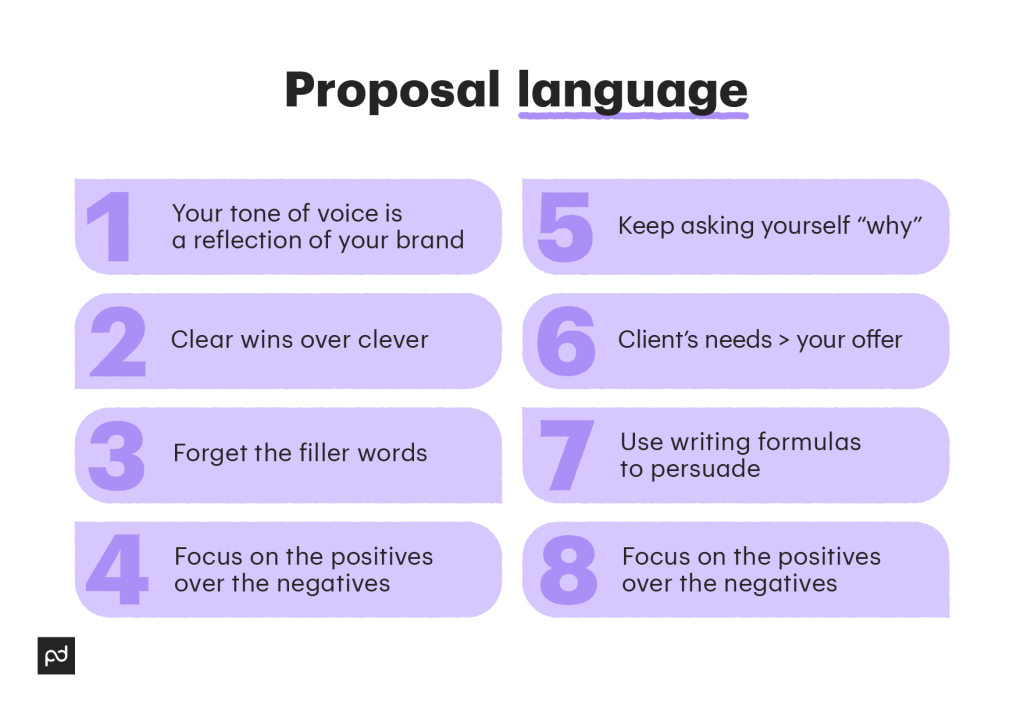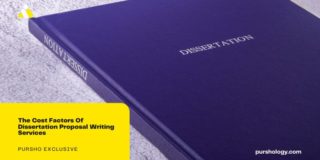Alright, we’ll just come out and say it: business proposal writing is no small feat.
These documents can essentially make or break a deal, and hence have high stakes associated with them.
And as Peter Parker’s uncle would undoubtedly say, with great stakes comes great writing responsibility.
The language, tone, and words you use in your proposal have a great impact on the final outcome you can get out of these important docs.
So, if you want to become a modern-day Shakesphere and learn how to write a winning proposal, then we’re here with our top 8 tips to help you get the language, tone, and words of your business proposal right.
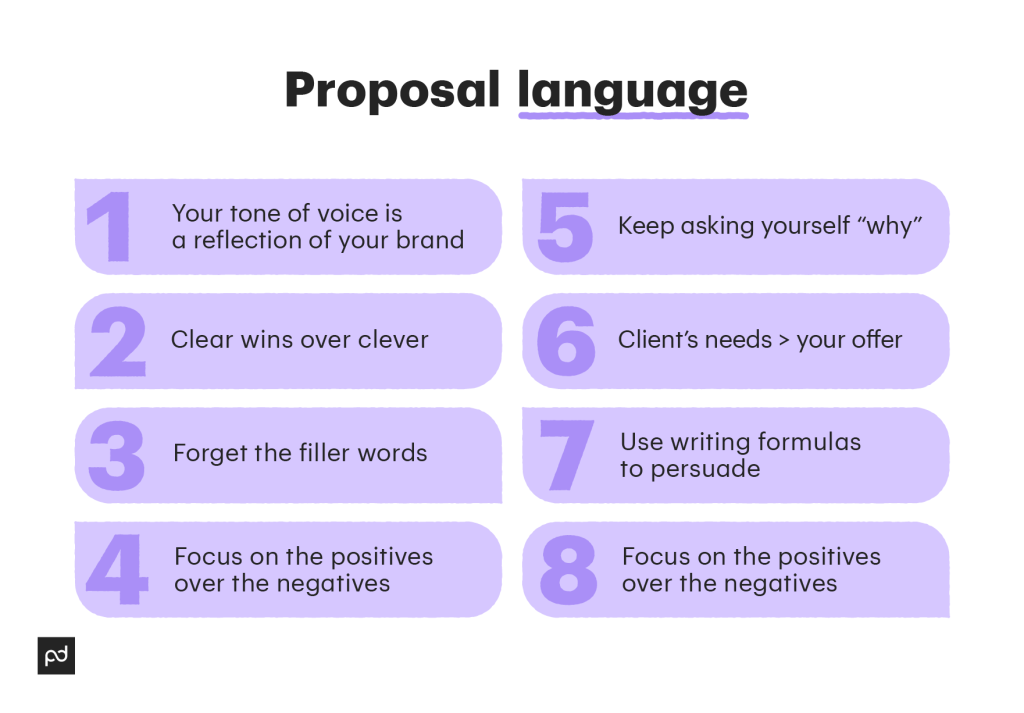
1. Your tone of voice is a reflection of your brand
If you had to personify Wendys and Apple, you’d probably come up with two distinct images.
Our guess is you’d imagine Wendy’s as peppy and Apple as preppy.
This is mainly because you set these two brands apart based on the way they communicate.
For example, Wendy’s would never back down from using clever comebacks, whereas Apple exclusively stays away from it.
On the other hand, Apple would only use a formal and friendly tone in communication, whereas Wendy’s wouldn’t mind being cheeky.
The point we’re trying to make is this: the tone that you use effectively becomes a reflection of your brand.
So, before writing any business proposal, know the tone of voice you want to set — friendly, formal, empathic, conversational, educational, or maybe something else entirely.
A word of advice: whichever tone you decide upon, make sure that it’s you.
For example, if you’re a young, fun company writing a digital marketing proposal for Wendy’s, you don’t want to come across as a stiff, formal brand — they’re probably looking for people who can keep up with their current image.
Oh, and also, there’s some level of formal talk expected out of business proposals, so don’t go all out and be irreverent and/or condescending toward your potential clients.
Let’s explore the concept of tone and voice a bit further.
What’s the difference between tone and voice?
While the terms “tone” and “voice” are often used interchangeably, the truth of the matter is, they each have distinct meanings.
Voice reflects the attitude of a brand or a person. Tone, on the other hand, has more to do with the way we speak.
For example, if we see Wendy’s on social media, the brand has a fun voice, but it has an informal tone.
In a similar way, Apple has an elegant voice.
But perhaps its tone is a touch too formal. In essence, the easiest way to mark a distinction between tone and voice is to think of yourself as the writer.
Your personality will get reflected through your voice (or your attitude), and your mood will get reflected through your tone.
You may have multiple tones but you will have only a single voice that becomes an accumulation of how you present yourself over the years.
For example, you can employ a sarcastic tone, a patronizing tone, an informal tone, etc., but your voice will represent how you view and interpret things.
2. Clear wins over clever
Let’s imagine Bob is writing a business proposal.
Bob’s point of focus is to look like the smartest guy in town, someone who knows all the jargon, and technical know-how.
Gary is also writing a business proposal.
He isn’t interested in sounding smart or cool, he just wants to get his idea across in an easy-to-understand way.
Yeah, don’t be Bob. Be more like Gary.
This is mainly because you aren’t writing a business proposal to show your potential clients you’re the smartest guy in town.
You’re writing a business proposal to show them that you understand their problem and you can get the work done.
On that note, if you can be both clear and clever, then all the better!
3. Forget the filler words
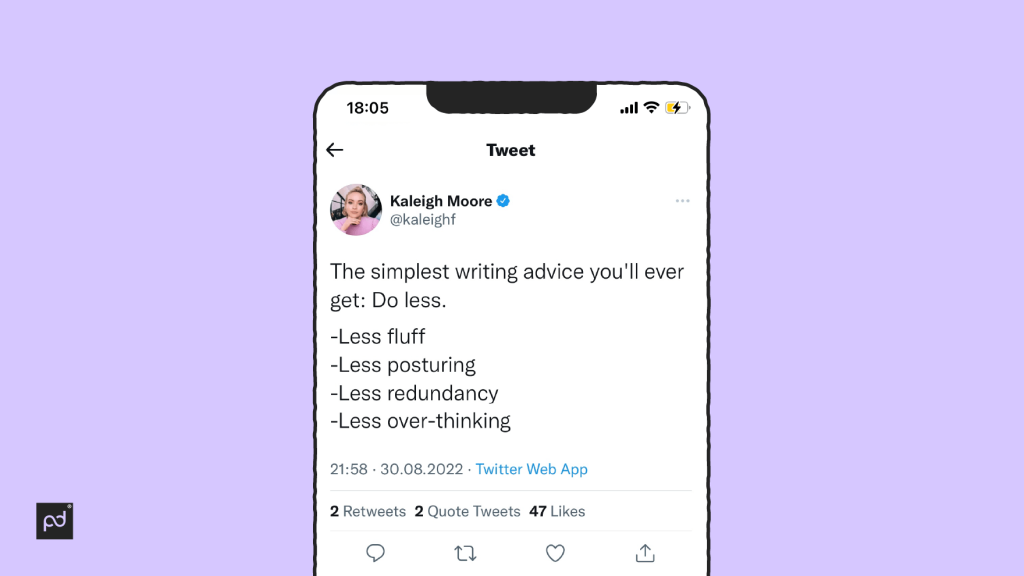
Redundancy is the ultimate enemy of any writer.
As someone writing a business proposal, your goal should be to avoid filler and fluff, and only to add information about the topics that need to be there.
In today’s day and age, everyone has a limited attention span, your potential clients included.
So, if you want to capture their attention and want them to read all the details about your project, then you’ll need to make strategic decisions on which information to keep and which to cut out.
Alternatively, you can also use templates, since these documents are already written by multiple writers, proofread by editors, and vetted by fact checkers and SMEs.
PandaDoc has an extensive template library which you can check out.
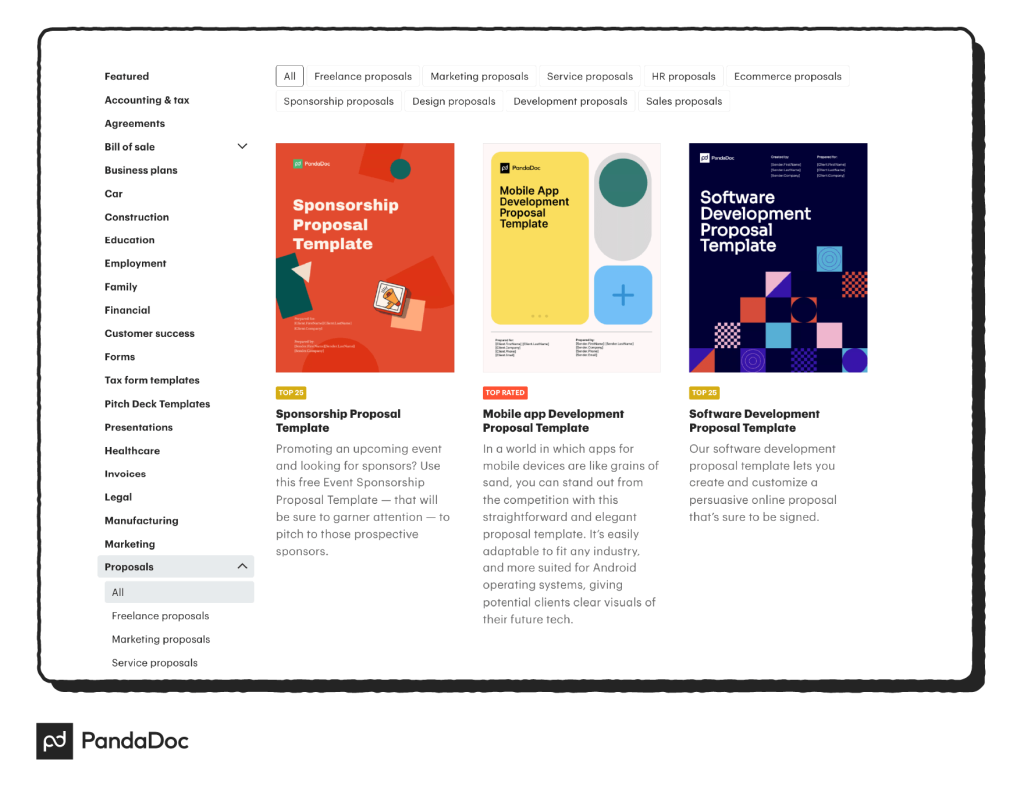
4. Focus on the positives over the negatives
The secret sauce of business writing is that you should focus on the benefits over the losses. Allow us to explain.
Suppose you’re a potential client who has sent out an RFP to digital marketing companies, and you receive two responses.
Proposal A writes about all the losses you’d face by not subscribing to their services (for example, you will not be able to target customers properly without Company A’s help).
Alternatively, Proposal B has all the benefits you can attain by using their services (for example, you will reach 2x customers with Company B’s help).
Now, as an unbiased party, keeping all other things equal, which proposal do you think would ideally have a better outcome?
The higher probability lies with Proposal B, because people buy into aspirations more than fear.
So if you could show them a better reality, as opposed to a future full of fear, they’d subscribe to the better reality much faster.
5. Keep asking yourself “why”
We previously spoke of how you should remove all fluff from your writing. Now, on to the part of what you should keep in your proposal.
The short answer is anything that adds value. The long answer is to add content that answers “why.”
Wondering why?
Allow us to delve further.
It’s easy to write about anything. However, to make your content make sense or add value to the reader’s life, you should need to tell them why it’s important.
Here’s how this scenario will work while writing a business proposal for a new client: if you’re writing a budget proposal, you’ll need to give justifications about why you’re spending the amount in question.
Or, if you’re creating a website development proposal, you’ll also need to tell the reader why they need certain services, etc.
Content is nothing without context, and the only way to add context is to answer “why.”
6. Client’s needs > your offer
Oftentimes, it’s easy to write about things that only benefit us.
For example, if you’re writing a consultation proposal, it might be tempting to write about your achievements, accolades, and companies you’ve worked with in the past.
Although those topics may form a good business proposal, to write a better proposal, you’ll need to focus on the client’s needs.
Structure your proposal around the client’s pain points and what you can do to address them.
7. Use writing formulas to persuade
A winning proposal is a goal.
But, how to create the perfect proposal that wins hearts and lands deals, you ask?
The answer lies with copywriting formulas.
Copywriting is a practice that has a few established formulas that attract the reader’s attention and keep them hooked on the page. Here are a few formulas you can consider:
- The 4Cs (clear, concise, credible, and compelling)
- The PAS formula (problem, agitate, and solution)
- Bridge before and after
- The AIDA methodology (attention, interest, desire, and action)
- Storytelling
Read more about these copywriting formulas here: 5 tried and true copywriting formulas. We imagine they’re Don Draper approved too!
P.S: These are just a few well-known copywriting formulas; there are many others out there that you can consider for your business proposals.
After all, different types of proposals will require different types of copywriting formulas.

8. Add in the golden words
Just like how the English language has a few golden words like please and thank you, the business proposal world operates on its own set of golden words.
These words depend from industry to industry, but most likely include:
- Strategy
- Impact
- Metrics (not the actual word; you can discuss metrics based on your industry type here).
- ROI
- Value
Create better proposals with PandaDoc
From the time you receive an RFP from a potential client, until the time you submit your business proposal, you’re always wondering how to set it right.
If you can perhaps modify the tone of voice, or rethink the headlines, maybe address the client’s pain points better.
It’s easy to second-guess every step you take.
This scenario is especially true if you’re a small team without an army of writers, editors, proofreaders, and fact-checkers to spearhead the project to ensure that you get a positive response from a potential client.
PandaDoc has those resources.
We extensively work with a large team of writers, editors, content heads, subject matter experts, etc., to ensure that the templates we write are fit to be sent to the client without a second guess.
So, if you want to get your hands on our template library (which has over 750+ easy-to-use templates for all your business needs), simply click here. It’s free!
Disclaimer
PandDoc is not a law firm, or a substitute for an attorney or law firm. This page is not intended to and does not provide legal advice. Should you have legal questions on the validity of e-signatures or digital signatures and the enforceability thereof, please consult with an attorney or law firm. Use of PandaDocs services are governed by our Terms of Use and Privacy Policy.
Looking For Document Management System?
Call Pursho @ 0731-6725516
Check PURSHO WRYTES Automatic Content Generator
https://wrytes.purshology.com/home
Telegram Group One Must Follow :
For Startups: https://t.me/daily_business_reads

